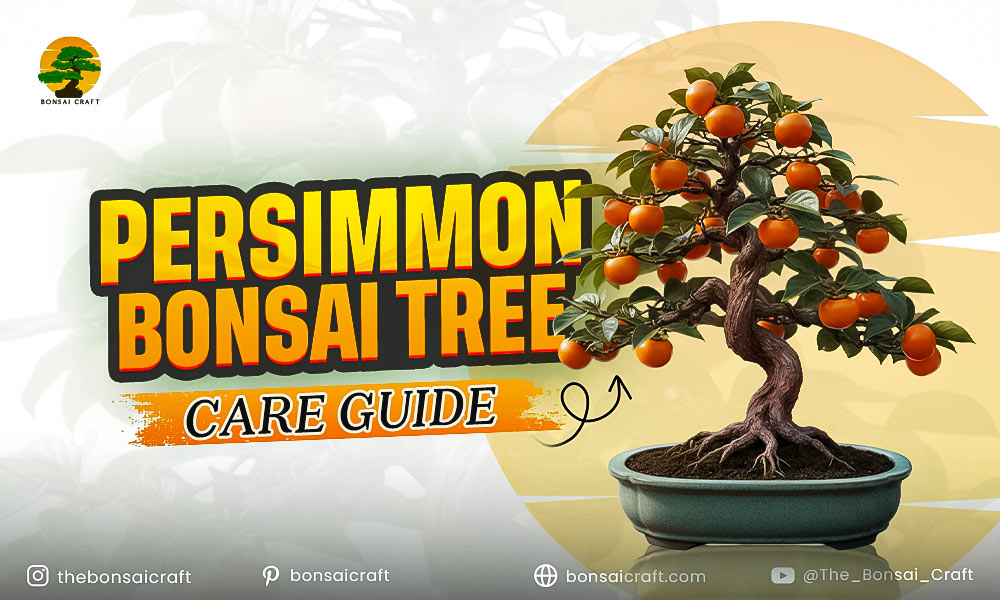
The persimmon bonsai tree is one of the most captivating fruiting bonsai species, admired for its glossy leaves, striking seasonal flowers, and vibrant orange fruits that resemble tiny lanterns. Unlike many bonsai that are primarily ornamental, the bonsai persimmon tree offers the added beauty of fruit-bearing, making it a unique centerpiece for collectors and enthusiasts alike.
From the delicate Princess Persimmon to the hardy American Persimmon bonsai and the exotic Japanese Persimmon bonsai, these trees combine elegance, resilience, and symbolic value. Caring for them requires knowledge of proper pruning, repotting, wiring, and seasonal attention to ensure long-lasting health and fruit production.
As a bonsai enthusiast and content strategist, I’ll share expert tips, horticultural best practices, and years of collective wisdom to help you master persimmon bonsai care.
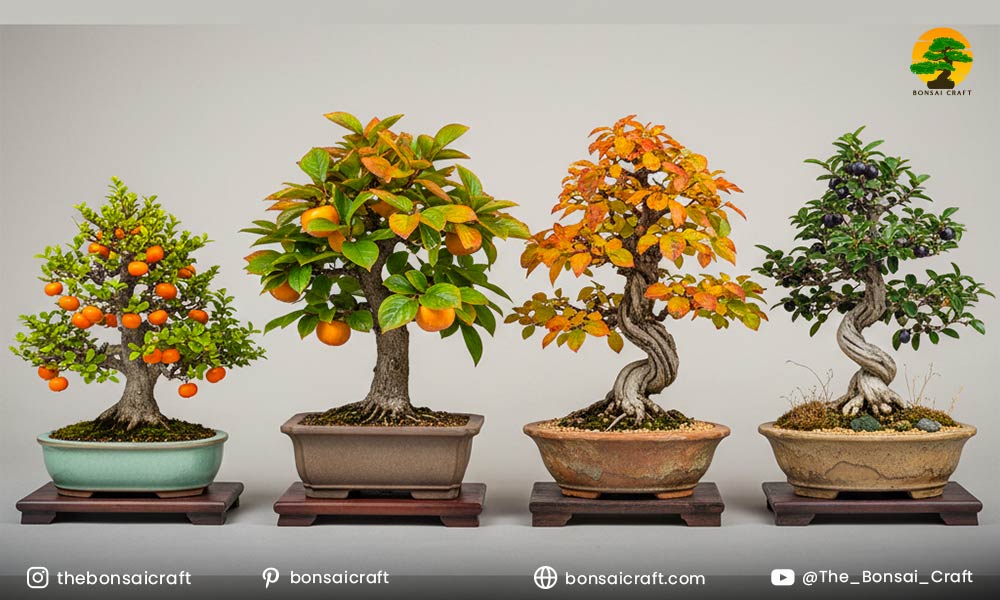
Understanding the Persimmon Bonsai Tree
The persimmon tree bonsai comes in several popular varieties:
- Princess Persimmon bonsai (Diospyros rhombifolia): Known for small, non-edible fruits and compact leaves, perfect for miniature bonsai styling.
- Japanese Persimmon bonsai (Diospyros kaki): Produces edible fruits and is a traditional favorite in Asia.
- American Persimmon bonsai (Diospyros virginiana): Hardy and adaptable, thrives in different climates, producing larger edible fruits.
- Texas Persimmon bonsai (Diospyros texana): A drought-resistant variety with small black fruits.
All persimmons share traits of slow growth, beautiful bark texture, and stunning fall foliage. They adapt well to training but need careful care to encourage fruiting.
Light Requirements for Persimmon Bonsai
Persimmon bonsai trees thrive in full sun to partial shade.
- Ideal Placement: Outdoors in a bright, sunny location. Indoors only if it’s placed close to a south-facing window with supplemental grow lights.
- Sunlight Needs: 5-6 hours of direct sunlight daily.
- Seasonal Adjustment: Provide afternoon shade in extremely hot climates to prevent leaf scorch.
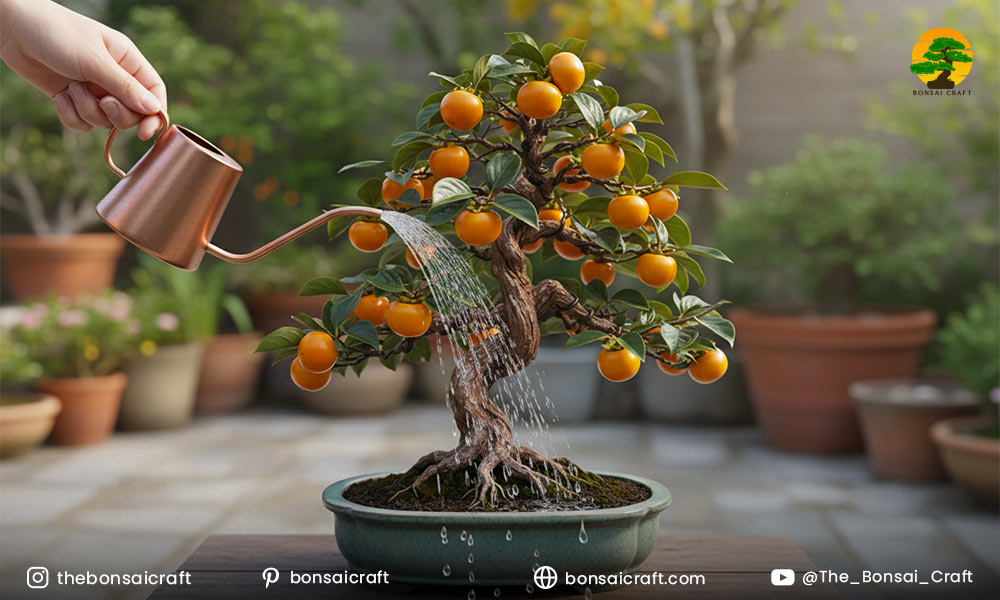
Watering Needs
How often should you water a persimmon bonsai?
Water your bonsai persimmon tree when the top 1–2 inches of soil become dry. Overwatering can cause root rot, while underwatering will stress the tree and reduce fruit production.
- Summer: Water daily or every other day, depending on temperature.
- Winter: Reduce the frequency of watering but prevent it from drying out completely.
- Best Practice: Use a watering can with a fine nozzle to soak evenly until water drains from the bottom.
Soil Requirements
The best soil mix for persimmon bonsai care is one that balances moisture retention with good drainage.
Recommended Mix:
-
- 40% akadama (moisture retention)
- 30% pumice (aeration)
- 30% lava rock (drainage)
This mix ensures strong root development and prevents waterlogging.
Fertilizing a Persimmon Bonsai Tree
How to fertilize a persimmon bonsai?
Fertilize during the growing season (spring through early autumn) to support fruiting and leaf growth.
- Spring/Summer: Use a balanced fertilizer (10-10-10) every 2–3 weeks.
- Late Summer: Switch to low-nitrogen, high-potassium fertilizer to encourage flowering and fruiting.
- Winter: Stop fertilizing when the tree goes dormant.
Tip: Organic fertilizers, such as fish emulsion or bonsai-specific pellets, are excellent for buxus bonsai care but equally suitable for persimmons.
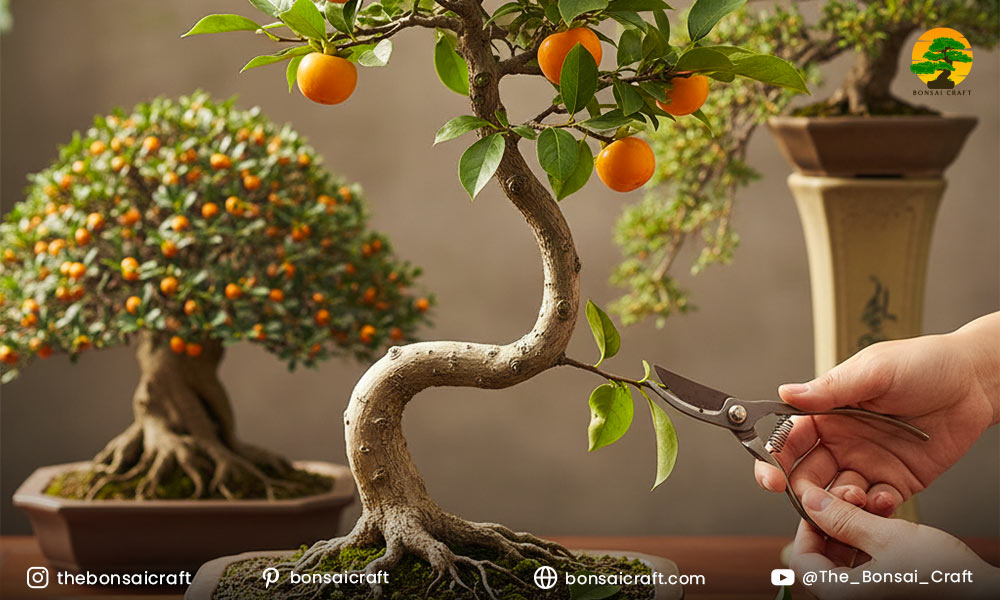
Pruning and Styling
When to prune persimmon bonsai?
The best time to prune a persimmon bonsai tree is in late winter or early spring before new growth begins.
- Structural Pruning: Remove crossing, dead, or weak branches to maintain balance.
- Maintenance Pruning: Pinch back new growth throughout the growing season to control shape.
- Fruit Consideration: Avoid heavy pruning after flowering; otherwise, fruit development may be reduced.
Styling Your Persimmon Bonsai
Common boxwood bonsai styles also apply to persimmons, but these species look especially stunning in:
- Informal Upright (Moyogi): Showcases trunk movement and fruit clusters.
- Broom Style (Hokidachi): Highlights dense leaves and small fruits, ideal for Princess Persimmon bonsai.
- Cascade (Kengai): Elegant flow of branches with hanging fruits.
- Forest Planting (Yose-ue): Create a redwood bonsai forest-like display with multiple persimmons.
Wiring and Shaping
- When to wire: Early spring or after pruning.
- Technique: Wrap wire at a 45° angle, gently shaping branches without cutting into bark.
- Duration: Leave the wire on for 2–4 months, monitoring regularly.
Since persimmon bark can scar, always use protective wrapping when wiring.
Repotting a Persimmon Bonsai
When to repot persimmon bonsai?
Repot young bonsai persimmon trees every 2–3 years in early spring before bud break. Older trees can be repotted every 4–5 years.
- Trim up to one-third of roots.
- Refresh with well-draining bonsai soil.
- Use a slightly larger pot if necessary, ensuring proper drainage holes.
Propagation of Persimmon Bonsai
How to grow cherry blossom bonsai from seed? (Comparison Example)
Like cherry blossom bonsai, persimmons can also be grown from seeds.
Steps for Persimmon Propagation:
- Collect ripe persimmon seeds in autumn.
- Stratify seeds in moist sand for 60–90 days at low temperatures (fridge).
- Plant in a bonsai soil mix in spring.
- Transplant seedlings once they reach 4–6 inches tall.
Alternative methods include grafting and air layering for faster results.
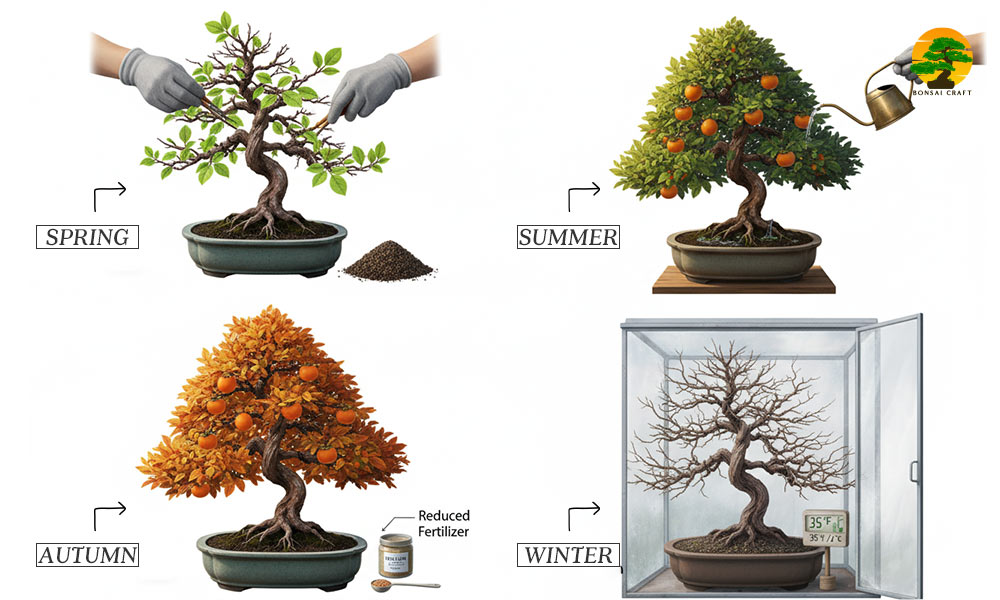
Seasonal Care for Persimmon Bonsai Trees
- Spring: Repot, prune, fertilize, and wire.
- Summer: Increase watering, protect from extreme heat, and monitor for pests.
- Autumn: Enjoy colorful leaves and fruits; reduce fertilization.
- Winter: To protect from frost, store in a cold frame or unheated greenhouse in temperate climates.
Common Pests and Diseases
- Aphids: Attack new shoots; control with neem oil or insecticidal soap.
- Scale insects: Cause leaf yellowing; remove manually or treat with horticultural oil.
- Leaf spot & root rot: Avoid by maintaining good airflow and proper watering.
Regular monitoring and seasonal preventive care keep your persimmon bonsai tree healthy.
Conclusion
Caring for a persimmon bonsai blends artistry with horticultural skill. Whether you’re training a Princess Persimmon bonsai, a Japanese Persimmon bonsai, or a hardy American Persimmon bonsai, success comes from consistent care—proper watering, pruning, soil management, and seasonal adjustments.
As an expert tip: patience is key. Fruiting bonsai like the bonsai persimmon tree reward growers not just with miniature beauty but with edible or ornamental fruits that symbolize abundance and longevity.
By following this guide, you’ll nurture a healthy, fruit-bearing bonsai that becomes a living heirloom.
FAQs About Persimmon Bonsai Tree Care
Can persimmon be used for bonsai?
Definitely! Persimmons make a wonderful bonsai due to their compact structure, shiny leaves, and remarkable fruit displays. With ample care, bonsai enthusiasts can enjoy them in both contemporary and classic styles.
When to prune persimmon bonsai?
The best time to prune a bonsai persimmon tree is late winter to early spring, just before the buds open. This helps to reduce stress and promote new healthy growth while keeping the tree’s fruiting ability.
How to grow a persimmon bonsai from seed?
Collect seeds in autumn, stratify them in cold storage for 60–90 days, then plant in spring. With patience, your persimmon bonsai tree can begin shaping within 2–3 years.
Can persimmon bonsai bear fruit?
Yes! With proper fertilization, sunlight, and pruning, Japanese and American persimmon bonsai can produce edible fruits, while Princess Persimmon bonsai produces small ornamental fruits.
When to repot a persimmon bonsai?
Repot every 2–3 years in early spring before new growth begins. Refresh soil, prune roots, and use a shallow bonsai pot with good drainage to maintain tree health.
